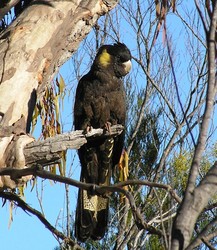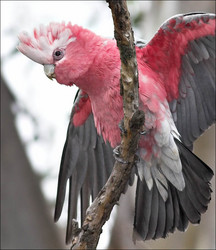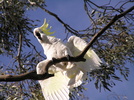Cacatuinae



This tree diagram shows the relationships between several groups of organisms.
The root of the current tree connects the organisms featured in this tree to their containing group and the rest of the Tree of Life. The basal branching point in the tree represents the ancestor of the other groups in the tree. This ancestor diversified over time into several descendent subgroups, which are represented as internal nodes and terminal taxa to the right.

You can click on the root to travel down the Tree of Life all the way to the root of all Life, and you can click on the names of descendent subgroups to travel up the Tree of Life all the way to individual species.
For more information on ToL tree formatting, please see Interpreting the Tree or Classification. To learn more about phylogenetic trees, please visit our Phylogenetic Biology pages.
close boxReferences
de Kloet, R. S. and S. R. de Kloet. 2005. The evolution of the spindlin gene in birds: Sequence analysis of an intron of the spindlin W and Z gene reveals four major divisions of the Psittaciformes. Molecular Phylogenetics and Evolution 36:706-721.
Title Illustrations

| Scientific Name | Calyptorhynchus funereus |
|---|---|
| Location | Girrawen NP, Queensland, Australia |
| Specimen Condition | Live Specimen |
| Source | P7190095 |
| Source Collection | Flickr |
| Image Use |
 This media file is licensed under the Creative Commons Attribution-NonCommercial License - Version 2.0. This media file is licensed under the Creative Commons Attribution-NonCommercial License - Version 2.0.
|
| Copyright | © 2004 Pierre Pouliquin |
| Scientific Name | Cacatua galerita |
|---|---|
| Location | Canberra, ACT, Australia |
| Specimen Condition | Live Specimen |
| Source | http://www.flickr.com/photos/pierre_pouliquin/66762309/ |
| Source Collection | Flickr |
| Image Use |
 This media file is licensed under the Creative Commons Attribution-NonCommercial License - Version 2.0. This media file is licensed under the Creative Commons Attribution-NonCommercial License - Version 2.0.
|
| Copyright | © 2006 Pierre Pouliquin |
| Scientific Name | Eolophus roseicapilla |
|---|---|
| Location | Newline, Canberra, Australian Capital Territory, Australia |
| Comments | These galahs were probably nesting and made a big song and dance as we walked past, apparently Galah language for "go away". This bird raised and spread every feather he had including a great view of his crest which you don't see all that often on Galahs. Galahs are another of my favourite birds, partly because of their exceptionally beautiful and sophisticated non-garish pink and grey colouring, partly because they have interesting personalities and partly because they are so common and generally maligned and dismissed and thus (at least in my view) deserve some positive discrimination for a change. |
| Specimen Condition | Live Specimen |
| Source | Galah flashing everything |
| Source Collection | Flickr |
| Image Use |
 This media file is licensed under the Creative Commons Attribution-NonCommercial License - Version 2.0. This media file is licensed under the Creative Commons Attribution-NonCommercial License - Version 2.0.
|
| Copyright | © 2007 Julian Robinson |
About This Page
Page copyright © 2007
 Page: Tree of Life
Cacatuinae.
The TEXT of this page is licensed under the
Creative Commons Attribution-NonCommercial License - Version 3.0. Note that images and other media
featured on this page are each governed by their own license, and they may or may not be available
for reuse. Click on an image or a media link to access the media data window, which provides the
relevant licensing information. For the general terms and conditions of ToL material reuse and
redistribution, please see the Tree of Life Copyright
Policies.
Page: Tree of Life
Cacatuinae.
The TEXT of this page is licensed under the
Creative Commons Attribution-NonCommercial License - Version 3.0. Note that images and other media
featured on this page are each governed by their own license, and they may or may not be available
for reuse. Click on an image or a media link to access the media data window, which provides the
relevant licensing information. For the general terms and conditions of ToL material reuse and
redistribution, please see the Tree of Life Copyright
Policies.
- First online 31 August 2007
- Content changed 31 August 2007
Citing this page:
Tree of Life Web Project. 2007. Cacatuinae. Version 31 August 2007 (temporary). http://tolweb.org/Cacatuinae/26408/2007.08.31 in The Tree of Life Web Project, http://tolweb.org/











 Go to quick links
Go to quick search
Go to navigation for this section of the ToL site
Go to detailed links for the ToL site
Go to quick links
Go to quick search
Go to navigation for this section of the ToL site
Go to detailed links for the ToL site